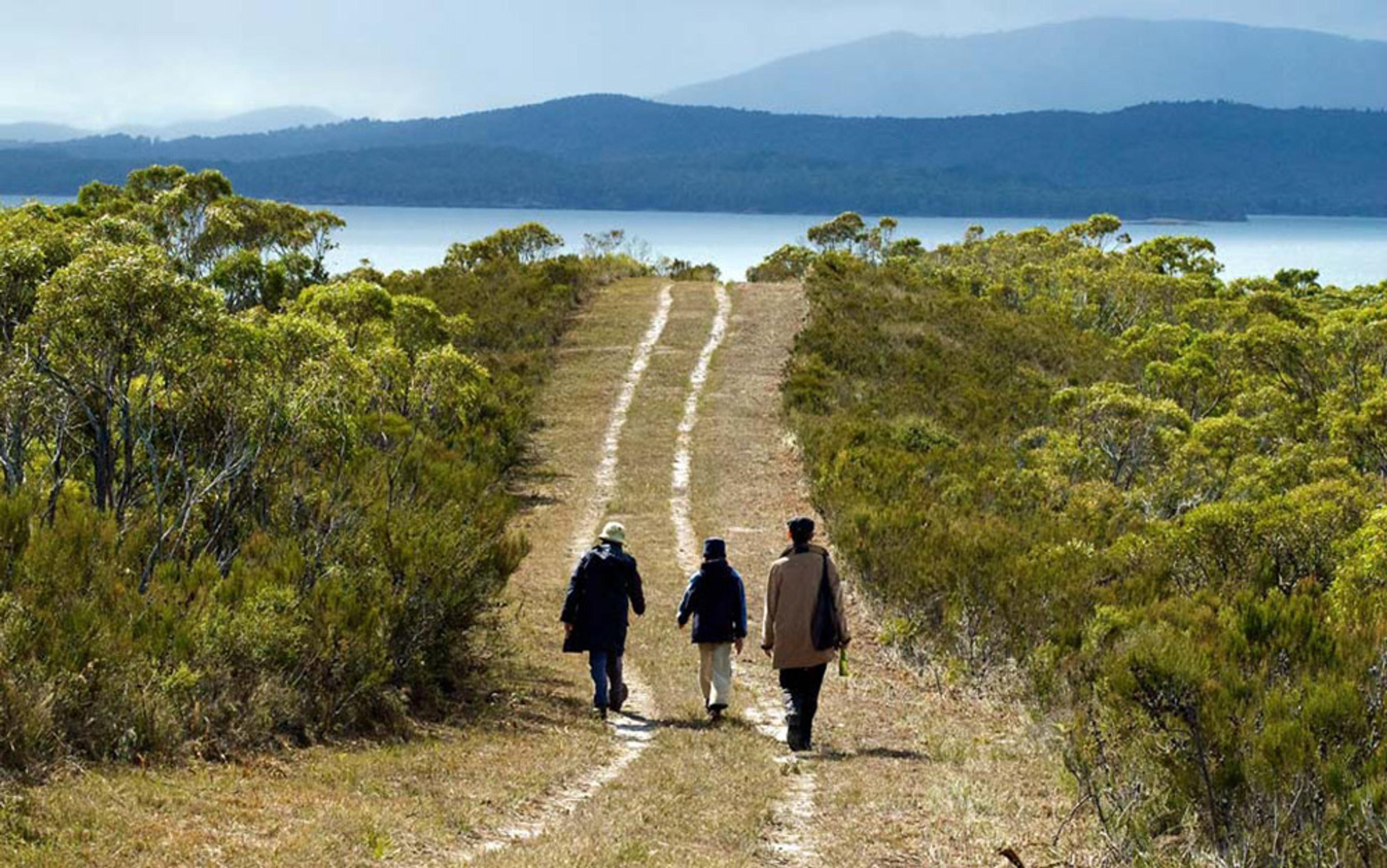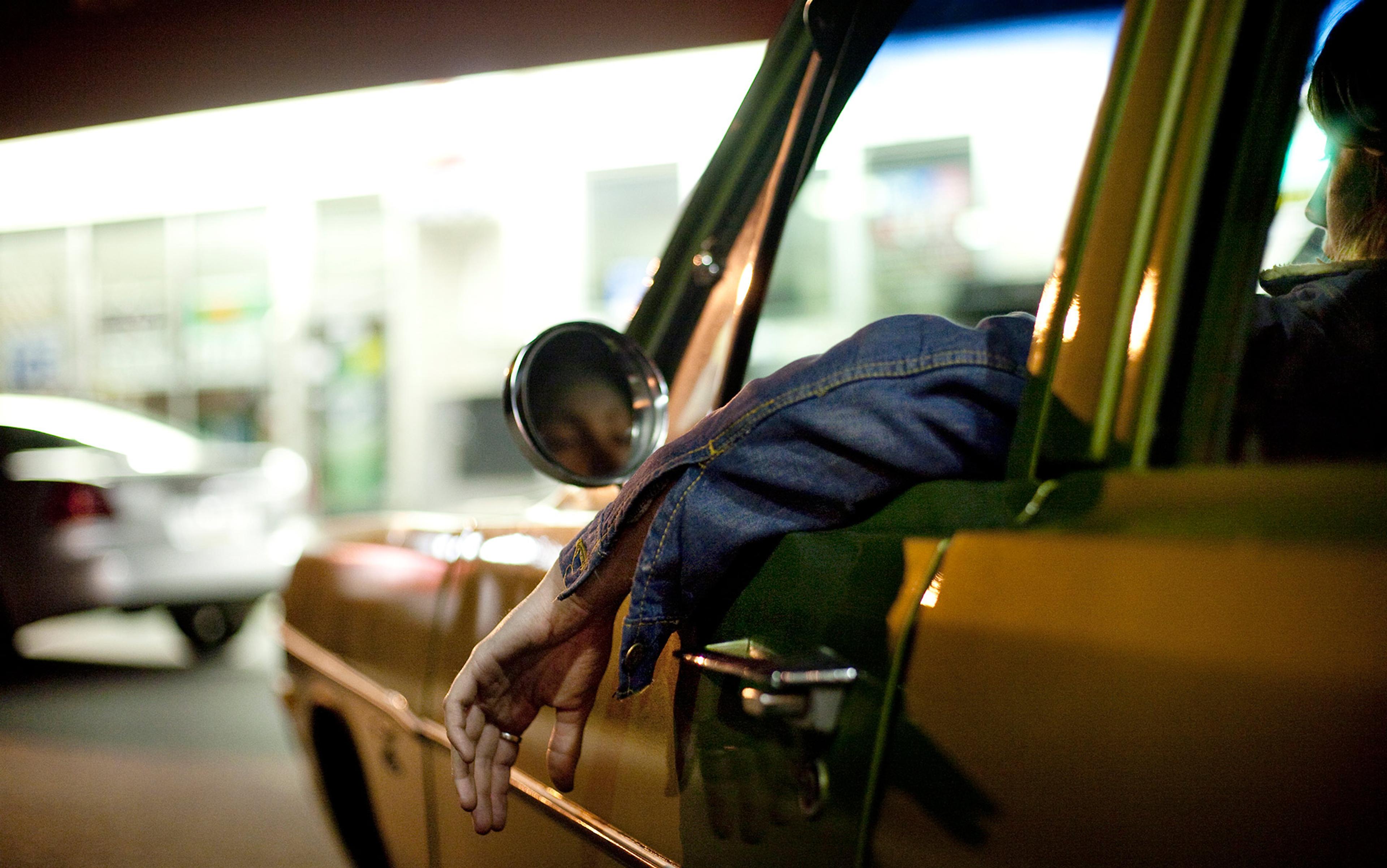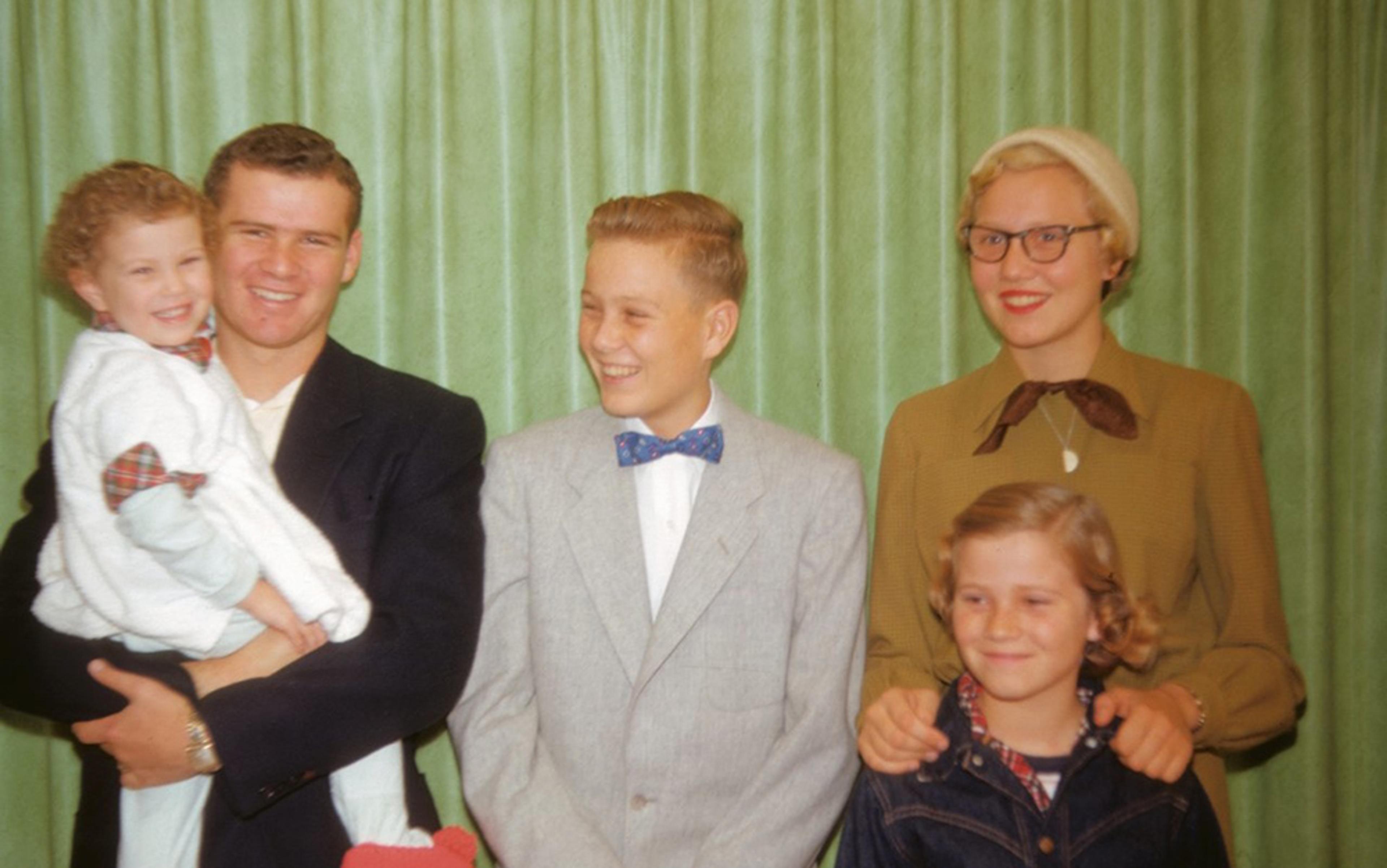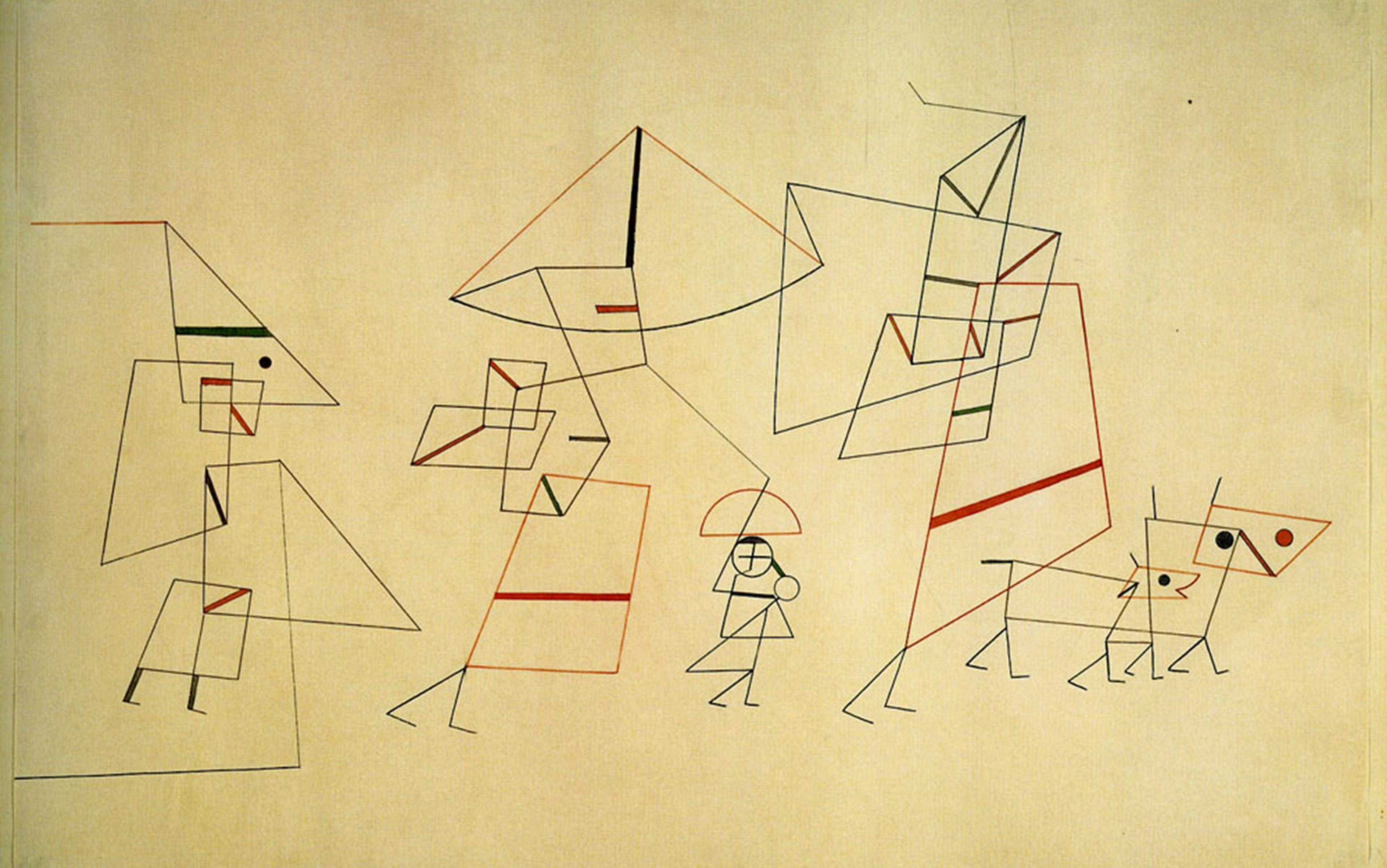Every few weeks my daughter and I stand back-to-back in the kitchen, socks off, our bare feet cooling on the tiled floor, and we measure up. I can feel her body elongate itself against mine, squaring pre-teen shoulders on my sloping ones, our bottoms taut with tension. We look like a totem pole – bodies melded together, stony faces pointing outward, chins up and arms pressed against our sides. My husband circles us, bending his knees to get all the angles and squinting like a surveyor. ‘Not quite there yet,’ he says. ‘There’s about two inches in it.’ Later he confesses to being spooked. ‘Looking at the two of you is like witnessing time travel,’ he tells me.
My daughter, who initiated this household ritual, has already dispensed with one yardstick: a month ago, just before turning 12, she overtook my mother. In her stride now, she is visibly delighted to be gaining on me. Standing on tiptoe and flinging an arm round my shoulders, she tries out equality and likes it. Soon enough there’ll be no need for any artificial elevation; we will be peers, in the matter of height, if nothing else.
My husband has already lost his way with the laundry. My daughter’s knickers, candy-striped and tartan-checked, regularly turn up in my drawers, while my tights have begun disappearing into hers. She wears them in the new fashion – opaque black legs under cut-off denim shorts. All the girls dress this way, come rain or shine, their toenails poking holes into their mothers’ tights.
I’ve begun to see my husband’s category errors as a way of re-drawing the boundaries of parenting. Having shared the job with me in a genuinely egalitarian, straight-down-the-middle sort of way for the first 11 years of our daughter’s life, he now, however unconsciously, seems to see our concerns forking into he-matters and she-matters. Underwear has become my domain, and now he need not think too hard about it. My own need to recalibrate my relationship to our daughter is just as pressing. But it is of a different order.
Every mother meets the paradox that the more their daughters are drawn into womanhood, the more they pull away. It is a confusing social induction that appears to obey strange magnetic rules: daughters are attracted to the adult world of women, but repelled by their actual mothers. Their resistance is primal, and fundamentally self-protective; how is a girl to acquire a distinct sense of her identity when every pubescent change in her body threatens to blend her into a confusing mélange with the woman who birthed her?
It is little wonder the father-daughter bond is often so strong – another thing that mothers must contend with. In my household, watching Star Trek re-runs and end-to-end episodes of The Simpsons are both folies à deux: as are American pancake feasts, not caring that the dog stinks, loafing in baggy T-shirts, confecting new-fangled desserts late at night, ice-skating, camping, and more. I’d be lying if I said I didn’t mind being excluded, even if this all sets a reassuringly high bar for the men who might come into our daughter’s life later. But I take her affinity for difference to be largely unavoidable. If a daughter is to separate properly from her mother, it stands to reason that she will cement that opposition by forging closer ties with her father.
Where this developmental dynamic is confined to just three souls, it is all the more potent. Besides, what complicates matters is my own need to detach from her. This is a developmental issue, particularly poignant for women in midlife, and yet seldom given proper attention.
If my daughter and I tussle it is because each of us, not just she, is striving to find her own ground: I, to sever myself from the young woman I once was, and of whom she so strongly reminds me; she, from a tyrannous feeling that she’s a mini-me – not just a doppelgänger, but her mother-in-training.
At the cusp of adolescence, my daughter is changing in ways that feel peculiar and unexpected – flesh filling out nascent curves, thick hairs sprouting willfully. With her biorhythms synched to a wayward chemistry, she’s become moody, lippy and self-conscious. A smart girl, she’s grasped that the source of her discomfort is the oddity of standing with one foot in childhood and the other in proto-adulthood. Her instinct is to hold firm to the ground she knows. While her classmates experiment with make-up and teenage posturing, she seems reluctant to put away childish things, as if she knows it’s her last hurrah when it comes to Minecraft, Sylvanian Families, secret spy books, and the Winx Club.
I’ve never felt us to be more mirrored. At the gateway to middle age, my body is also changing in surprising ways: my skin is papery, my joints click and pop. While her hormones rage, mine are plummeting. She’s discovered sleep. I’m suddenly insomniac. Her memory is a fine-tuned thing. Mine’s perpetually tripping up. At the same time, both of us ricochet between crankiness and euphoria. To my great irritation, I am once again prone to occasional outbursts of acne, just as she breaks out in spots. After decades of feeling comfortable in my skin, I, too, am now deeply self-conscious.
Not surprisingly, ours is a household of fireworks; one of us, my daughter or me, can always be relied upon to ignite the other’s latent and explosive instability.
But what’s really at the root of our twinship? Is it simply a product of my having postponed parenthood until my late thirties, so that my daughter hits adolescence just as I encounter menopause? Or is there more to me identifying with her every bit as much as she identifies with me?
Suzanne Braun Levine, the original editor of Ms. magazine and now a midlife guru, invokes the phrase ‘second adulthood’ to describe a phase of ‘existential bewilderment’ that afflicts women in midlife and is every bit as traumatic as adolescence. As we enter it, we wobble. We question everything we once took for granted. We experiment, re‑evaluate, take risks, confront our fears, ask ourselves who we are and where we think we’re going. Our metaphysical, practical and emotional concerns collapse together as they are brought to bear on a single question: our suddenly malleable identity. This evaluative project suggests that there’s more to mother-daughter mirroring than either biology or chronology can account for. But Braun Levine is merely a populariser: the key to that more is to be found in the work of the German-born developmental psychologist Erik Erikson.
Erikson, who died in 1994 at the age of 91, coined the term ‘identity crisis’. A devoted follower of Freud, as a young man he moved to Vienna and threw himself into a crucible of psychoanalytic ferment, training with the Gestalt psychologists Karl and Charlotte Bühler, and eventually with Anna Freud. Later, he would liken those years to ‘the Paulinian days of Christianity’. The metaphor is telling, since Freud’s early apostles would also re-write the basic creed for a new generation of acolytes. With Hitler’s rise to power, Erikson left Europe for America, where he held a succession of posts in prestigious universities as a specialist in the field of child psychoanalysis.
Over the coming decades, Erikson would deviate from Freudian orthodoxy in a number of highly significant ways. He came to believe, for example, that the ego was more than merely a servant of the id (implying that we are less subject to inner drives and more influenced by our conscious desires), and that the wider environment in which a child lived was as critical to her emotional development and identity formation as the psychodynamics of her family. He also came to see development as a lifelong process – not as something that was formed and fixed in infancy, as Freud had always insisted. Erikson argued that, just as parents influenced a child’s development, they were, in turn, profoundly affected by their children.
In 1950, and with a good deal of unsung input from his Canadian wife Joan, Erikson came up with a seven-stage theory of personality development, inspired by Shakespeare’s seven ages of man. Each stage was characterised by a ‘psychosocial crisis’, and this crisis had to be resolved before a person could progress to the next stage. If unresolved, the result was a kind of arrested development. One day, while driving Erik from their Berkeley home to the train station in San Francisco, Joan had a revelation: ‘Hey, we left ourselves out!’ she shouted. They were both 48. By the time they’d reached the station platform, the Eriksons had fleshed out an eight-stage development model, now including a phase they called ‘generativity’ representing middle age.
‘An adult must be ready to become a numinous model in the next generation’s eyes’
Each Eriksonian stage brings with it a form of enrichment, or ‘virtue’. For example, stage six, or young adulthood (roughly, ages 20-40), sees the individual forging solid relationships and lifelong partnerships by negotiating a psychosocial crisis that pits the needs of intimacy against those of isolation; its associated virtue is love. The succeeding midlife crisis (in stage seven, adulthood, ages 40-65) demands that we embrace ‘generativity’ over self-absorption and go on to embody the virtue of ‘care’. If we fail to do so, we run the risk of stagnating and of sliding into unhappy narcissism.
By generativity, Erikson included all kinds of giving back to society: the production of art, the reproduction of children, the support offered to younger generations, a deeper engagement with society. As Erikson put it: ‘An adult must be ready to become a numinous model in the next generation’s eyes and to act as a judge of evil and a transmitter of values.’
All of this rings true to me, especially the idea, central to adult development theory, that there is no single self, only multiple selves, or a succession of selves; that we keep changing, keep growing. It suggests that real gains might be had from the tribulations of midlife, not just its weak consolations, and that life’s arc might trace an upward curve instead of a slow downward spiral. As an added boon to my mother-daughter mirroring, the generative agenda suggests that my daughter and I move forward in parallel, each of us unmooring from one stagnant self and chugging off along life’s meandering stream to find another. Perhaps, in fact, it is only in consequence of this mutual separation that we will eventually find our way back to each other.
Erikson’s eight-stage development model was extremely influential in America, though it remained unpopular with the psychoanalytic fraternity in Europe to whom it seemed, well, rather too accommodating of life. In shifting the emphasis from psychosexual trauma to psychosocial crises, the model located the struggle to achieve a stable identity not in the permanent internal warfare of the psyche, as Freud had done, but in the tension between self and society. With studied application, argued Erikson, that tension might be resolved in the individual’s favour, leading to psychic peace. However, the question of whether Erikson managed to resolve this tension in his own life is debatable. His biographer Lawrence J Friedman believes that the Eriksons never came to enjoy psychic peace, because they were keepers of a dreadful secret that undermined the picture-perfect family image they so assiduously maintained in public.
In 1944, Joan gave birth to their fourth child Neil. The boy was born with Down’s syndrome, which was then poorly understood. Down’s children were not expected to live very long and, if they did, they were deemed too ‘retarded’ to survive in the social and educational mainstream. A decade or so later, the American paediatrician Benjamin Spock would revolutionise such thinking, and with it the fortunes of Down’s children, by recommending that their lives should be as normal as possible and that they should remain at home with their parents and siblings. But in the 1940s, such children were commonly institutionalised.
With Joan under heavy sedation after Neil’s birth, doctors at the hospital pressed Erik to agree to send him away before mother and baby formed a strong bond. Erik was distraught. But after consulting with friends, among them the anthropologist Margaret Mead, he agreed. Neil would be sent away immediately, and no one else but Joan need ever know that he’d survived birth – including two of the Eriksons’ three existing children.
Friedman is convinced that Erikson’s guilt over this decision led him to focus on mapping out a thoroughgoing scheme of normal development – one that might buoy the family of five at home in Berkeley. He suggests too, that the guilt of lying to their children by telling them that Neil had died was a driving force in the Eriksons’ formulation of the generative stage of adult development.
Friedman’s argument is tantalising, especially when one considers the damage wrought when mother and child are prevented from attaching, and then from undergoing normal separation. I shudder to think of the developmental limbo that Joan Erikson was forced to endure as she entered middle age, assailed by doubts over the rightness of their actions. In secret, she visited Neil a number of times, but she found these visits increasingly upsetting, and eventually stopped going. Neil was withdrawn and unable to give her the dispensation she craved by rewarding her with some kind of relationship.
As a footnote, around the time that Erik published Childhood and Society (1950), the book that would catapult him into the limelight, Joan arranged for the family to move to nearby Orinda, where she took up voluntary work at a local hospital helping patients with mental illness to reintegrate into the world.
In recent decades, the Eriksons’ development model has been given an unexpected boost from research in neuroscience that has begun to uncover empirical evidence of significant developmental change in midlife. In the 1990s, the Harvard Medical School research scientist Francine Benes made a pioneering discovery while studying adolescent brain development. She found that the adolescent brain undergoes a pronounced increase in myelination – a form of growth that boosts the brain’s processing power by enhancing the way neurons conduct electrical signals. To highlight this peak in brain development, Benes and her colleagues compared the growth of the adolescent brain against a control group of 164 people, aged between zero and 76. That’s when she noticed a second spike: the brain, it transpired, underwent a second, wholly unexpected, growth spurt in middle age. The implications for cognitive science were huge.
Harvard retains a pioneering role in this line of research. In 2013, On the Brain, the newsletter of the university’s Mahoney Neuroscience Institute, was devoted to a state-of-the-art survey of the middle-aged brain. Though still a young field, research into neuroplasticity – that is, the human brain’s structural ability to reconfigure itself – is uncovering numerous ways in which designated specialist areas in the brain can be re‑purposed, re-wired or retro-fitted, and thus functionally transformed – although the extent to which life experience might spur such change remains highly controversial.
Erik Erikson lived just long enough to learn about the rich findings in cognitive science that so resolutely back the development theory he formulated half a century earlier. I like to think that in reading about neuroplasticity he enjoyed cocking a final snook at Freud.
generativity is not something you can achieve in isolation. It is a process in which some kind of mirror is essential
Personally, what I cherish about Erikson’s model is the work it demands of us in progressing through its various stages. It pushes back against the self-help movement, with its lazy thinking and easy answers – and its chorus of witchy and wise female elders who regard middle age as some kind of bad weather system: something dark and brooding that storms briefly but soon passes, leaving everything refreshed. In its wake, say the self-helpers, there is sunshiny wisdom and patience, life lived at an unhurried pace, grandchildren, knitting, lots of sage nodding, and not a few encouraging winks to those still under the rainclouds.
In the self-help model, you are your ‘Youniverse’. By contrast, generativity suggests that midlife’s rewards are the end products of hard work that displaces ‘you’ from the centre of your world. In other words, generativity is not something you can achieve in isolation. It is a process in which some kind of mirror is essential. Braun Levine seems to grasp this, putting family dynamics into the mix when arguing that women empower themselves by channeling the midlife storm. Viewed this way, development is relational, negotiated, a trade-off of one thing over another. But even Braun Levine, at the sophisticated end of the self-help movement, does not want to acknowledge that, before any kind of development (let alone re-birth) can occur, a process of mourning or grieving is essential. This mourning takes varied and complex forms: but among them is self-burial.
I am not generally given to sentiment, being of the firm opinion that it blunts the intellect. But I am sentimental about my daughter. When she was newborn, I shed tears for all the hurt she would inevitably experience over the course of her life. To my febrile post-partum brain, her entire future was concertinaed into a series of worrying spikes: her first disappointment, her first bust-up with a friend, her first heartbreak, her first loss – a whole world of pain that I had selfishly ushered her into. I put this maudlin cast of mind down to erratic hormones, but the sentimentality persisted.
Exhibit A: in my cupboard there is a shoebox in which I’ve stowed one representative of each of her early shoes, from the soft-soled, elasticated chamois she once toddled about in, to her first Velcro-strap school shoes.
Exhibit B: in a tiny black-lacquered box with red satin lining, I’ve kept the desiccated remains of the living cord that once bound us together. It was tied in a knot at her navel before she was handed to me, like a gift, at the birthing clinic; then it fell off, starved of blood supply, a couple of weeks later.
Exhibit C: another box – one I intend to return to her some day – of recreational work from her first 10 years: choice drawings and painterly daubings, spy tales, mermaid diaries, notebooks filled with hilarious lists, and a card she made for my 48th birthday, picturing a cake and candles, and captioned ‘Mummy, we are all ageing!’
These days, I am practically infected with sentiment. But it has taken a new form – a nostalgia in which my own remembered (and now lost) youth has become entangled.
I must first let go of my ghostly younger selves – the grown-up version of putting away childish things
At the opposite end of the reproductive spectrum, I am acutely aware of the threshold at which my daughter stands today. I want to wave at her in sympathy and recognition, and assure her it will turn out well. I want to tell her that on the other side of this difficult transition there will be freedoms and experiences she’s never dreamt of, as well as new heights of confidence and competence. There will be deep friendships and deeper loves, the rollercoaster of university life and first jobs, independent travel, opportunities at every turn. I want to tell her that her dreams will become tangible. That her fears will drift into obscurity. That she will feel invincible.
But then I am overcome by a terrible sadness for my own lost opportunities, and by an ersatz nostalgia for paths not taken – a missing, if you like, of what I never had, and a misplaced anxiety about all the future paths I shall never take, because with middle age comes a shrinking sense of the possible. Since half of me is lost in undifferentiated yearning for what might have been, I’m often unable to reassure my daughter with the right level of conviction. If I am to succeed in this task, I must first let go of my ghostly younger selves – the grown-up version of putting away childish things.
What I can tell my daughter is that the world of unknowns before her is not so frightening as she thinks. Or, more accurately, it is less frightening than it is limiting – every choice freighted with the responsibility of eclipsing another choice: every road chosen a path not taken.
Modern physics has come up with a comforting metaphor that addresses this anxiety about not being able to have it all: the many worlds hypothesis. Originally developed as a response to the uncertainty inherent in quantum theory by the British physicist Hugh Everett in 1957, it went on to have an afterlife as a thought-experiment. According to the many worlds hypothesis, all possible histories and futures are real. Every path you can imagine taking is actually taken, in one universe among a multitude of universes. Of course, physics – however philosophically you slant it – is morally neutral: it cannot tell us in which universe our choices lead to greater fulfilment.
It suggests to me that we ought to tear up our conventional blueprints. There is a roadmap for much of our lives, neatly plotted out. In simplistic guise, it goes something like this: your teens are for studying, your twenties for experiments and fun; in your thirties you consolidate (careers, relationships, finances) and start parenting; in your forties you acquire stature and kind of peak; and in your fifties – the horizon I am now looking towards – the lucky few get to peak again, while others experience middle age as a kind of mugging, robbing them of a feeling that the future might actually hold more than the past.
Many worlds theory suggests that this conventional (and admittedly first‑world) blueprint is no better than any other prescribed path. In any case, those who hew most closely to its contours in youth end up feeling most lost in middle age. Where that leaves me in terms of counselling my daughter through adolescence is not entirely clear. But I wish to encourage her to embrace The Unknown. After all, with every step you take into the murk, the fog recedes a little.
In the best of my idealised scenarios, she and I journey into the unknown together as our mirroring continues. She departs from the blueprint as much as she likes, learning and adventuring by turn, while I venture into my foggy fifties, one air-clearing month at a time. There will be hard developmental work to do, and as much forgetting as generative re-inventing. But all the while I can comfort myself that in other universes, far, far away, a series of other 50-year-old versions of me will be suffering every fate I’ve managed to escape: early retirement, divorce, grumpiness and general depression, loss of hope, lassitude and bankruptcy.
This essay offers a taster from Marina Benjamin’s memoir, The Middlepause, on turning 50, published by Scribe UK.






